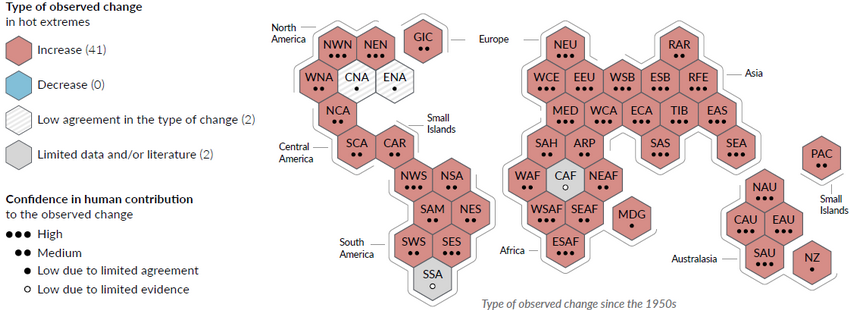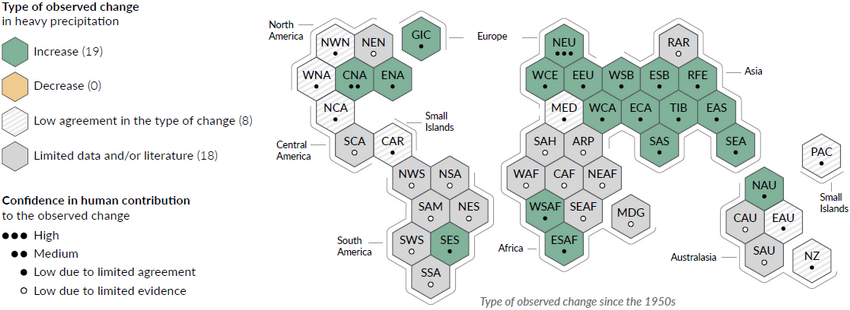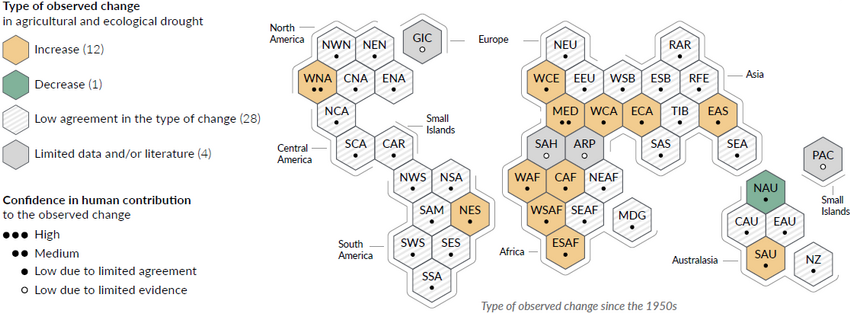Global Climate Change - Extreme weather events
Global Climate Change |
|||||||
|
|||||||
Human-induced climate change is already affecting many weather and climate extremes in every region across the globe. Evidence of observed changes in extremes such as heatwaves, heavy precipitation, droughts, and tropical cyclones, and, in particular, their attribution to human influence, has strengthened since the Fifth Assessment Report.
|
Hot extremesHot extremes have become more frequent and more intense across most land regions since the 1950s, while cold extremes have become less frequent and less severe.
Observed change in hot extremes and confidence in human contribution to the observed changes (Image credit: IPCC AR6)
|
Heavy precipitationThe frequency and intensity of heavy precipitation events have increased since the 1950s over most land area for which observational data are sufficient for trend analysis.
Observed change in heavy precipitation and confidence in human contribution to the observed changes (Image credit: IPCC AR6)
|
DroughtsHuman-induced climate change has contributed to increases in agricultural and ecological droughts in some regions due to increased land evapotranspiration.
Observed change in agricultural and ecological drought and confidence in human contribution to the observed changes (Image credit: IPCC AR6)
Note: IPCC AR6 WGI reference regions: North America: NWN (North-Western North America, NEN (North-Eastern North America), WNA (Western North America), CNA (Central North America), ENA (Eastern North America), Central America: NCA (Northern Central America), SCA (Southern Central America), South America: NWS (North-Western South America), NSA (Northern South America), NES (North-Eastern South America), SAM (South American Monsoon), SWS (South-Western South America), SES (South-Eastern South America), SSA (Southern South America), Europe: GIC (Greenland/Iceland), NEU (Northern Europe), WCE (Western and Central Europe), EEU (Eastern Europe), MED (Mediterranean), Africa: MED (Mediterranean), SAH (Sahara), WAF (Western Africa), CAF (Central Africa), NEAF (North Eastern Africa), SEAF (South Eastern Africa), WSAF (West Southern Africa), ESAF (East Southern Africa), MDG (Madagascar), Asia: RAR (Russian Arctic), WSB (West Siberia), ESB (East Siberia), RFE (Russian Far East), WCA (West Central Asia), ECA (East Central Asia), TIB (Tibetan Plateau), EAS (East Asia), ARP (Arabian Peninsula), SAS (South Asia), SEA (South East Asia), Australasia: NAU (Northern Australia), CAU (Central Australia), EAU (Eastern Australia), SAU (Southern Australia), NZ (New Zealand), Small Islands: CAR (Caribbean), PAC (Pacific Small Islands)
|
Image credit: Figure SPM.3 from IPCC, 2021: Summary for Policymakers. In: Climate Change 2021: The Physical Science Basis. Contribution of Working Group I to the Sixth Assessment Report of the Intergovernmental Panel on Climate Change [Masson- Delmotte, V., P. Zhai, A. Pirani, S. L. Connors, C. Péan, S. Berger, N. Caud, Y. Chen, L. Goldfarb, M. I. Gomis, M. Huang, K. Leitzell, E. Lonnoy, J. B. R. Matthews, T. K. Maycock, T. Waterfield, O. Yelekçi, R. Yu and B. Zhou (eds.)]. Cambridge University Press. In Press. |


